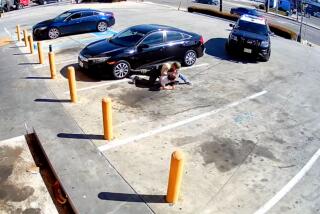Rape Report Wasn’t Passed on to Task Force
- Share via
A rape victim recently sought by law enforcement officials investigating a series of prostitute killings has come forward and told investigators that she reported the assault to the San Diego County Sheriff’s Department three years ago, authorities confirmed Monday.
In a mix-up that a spokesman for the Metropolitan Homicide Task Force said fell “through the cracks,” the Sheriff’s Department investigated the rape but never forwarded its findings to the task force.
Sheriff Jim Roache acknowledged Monday that his department took a rape report but was never asked by the task force to send along such reports as part of the agency’s investigation of dozens of slain prostitutes, transients and drifters that began in 1988.
At a news conference 10 days ago, the task force asked the public’s help in identifying the woman, who was raped three years ago near the Buckman Springs rest stop off Interstate 8.
Task force spokesman Dick Lewis suggested during the rare news briefing that the method of attack and location in East County, where so many of the 45 bodies of prostitutes and transients in the killings were found, stirred the agency’s interest.
“Learning the identity of this victim is essential in aiding the ongoing task force investigations,” the agency said in a prepared statement.
Several days after the news conference, the woman contacted the task force and said she had reported the rape to the Sheriff’s Department the day it occurred in the summer of 1988, officials said.
“It is my understanding that there was a report made,” Lewis said Monday. “Any time there is reporting that falls through the cracks . . . I don’t like it.”
Lewis could not explain why the task force did not inform the media that the woman had come forward after the task force had trumpeted the search for her at its news conference.
The task force, which is composed of representatives of the Sheriff’s Department, San Diego Police Department, county district attorney’s office and state attorney general’s office, is investigating the mix-up.
Roache said he has done his own investigation and concluded that the rape report was “thoroughly and completely investigated.” He said officials believed the rape “had no connection to the serial murders” in 1988, but that recently “we’ve learned this case has some relationship to the serial murder.. . .”
Lewis said the delay in forwarding the report probably has more to do with the number of law enforcement officials in San Diego County and the huge volume of reports they process.
“You’re dealing with 2,000 police officers and 1,000 sheriff’s deputies and all these other police agencies,” he said. “It comes down to the perception of individual people whether a report is important enough” to send to the task force.
Law enforcement officials have been criticized recently for the handling of other evidence related to the killings. The husband of one victim, Carol Jane Gushrowski, said he could not understand why it took investigators 4 1/2 years to identify his wife’s body, even though it was discovered 27 days after he filed a missing persons report.
The brother of Linda Christine Marler, another victim, said police refused to take a missing persons report on his sister because she had an outstanding arrest warrant.
The mother of Cynthia Maine, a prostitute and police informant who disappeared in 1986, has complained about the task force showing little interest in finding out what happened to her daughter.
In the latest case, involving the rape victim, Lewis said the three-year delay in getting to the woman did not hinder the investigation because of “other circumstances that we cannot get into.”
When the task force was formed three years ago, it tried to “construct as accurate a base line as possible of all the information that was available” about the killings, Assistant San Diego Police Chief Norm Stamper said. “It is entirely possible that you would not necessarily have connected a rape case to the murders.”
The rape victim recently came to the attention of the task force, Lewis said, after investigators interviewed a woman who met the victim at the Buckman Springs rest stop just after the assault.
The woman told the task force that the rape victim had been hitchhiking when a man driving a truck picked her up and drove to an automatic teller machine. The pair then drove to a hang-gliding strip near Buckman Springs Road, where he raped her, the woman said.
Lewis said the woman has provided good information about the attacker.
“We are talking to the woman and doing some other stuff, and I want to thank everyone for their assistance,” Lewis said Monday. “I want to get our investigation fleshed out with this woman. She’s been very helpful.”
Of the 45 cases under scrutiny by the task force, all but three are unsolved. Because of the way the bodies were dumped and the North and East County locations where they were found, investigators believe that some of the killings are the work of one killer.
Lewis has said the task force has six or seven “good suspects” under investigation, but would not say how close they are to making another arrest.
Police Chief Bob Burgreen has vowed to find out who is responsible for Maine’s disappearance as well as for the death of Donna Gentile, a second prostitute and police informant who was found dead shortly after her testimony against two police officers in a Civil Service hearing. Both women claimed to have had personal involvement with police officers.
One branch of the task force investigating possible police corruption concluded last month that a number of allegations, including the possibility that police officers were having sex with prostitutes employed by “Rolodex Madam” Karen Wilkening, were unfounded. Their findings were released in a county grand jury report.
More to Read
Sign up for Essential California
The most important California stories and recommendations in your inbox every morning.
You may occasionally receive promotional content from the Los Angeles Times.









